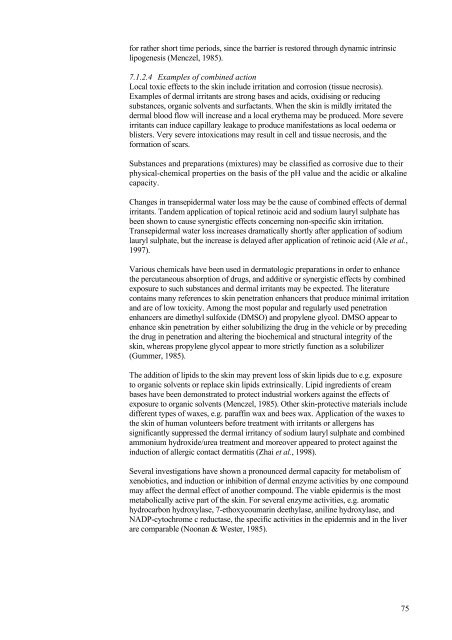Combined Actions and Interactions of Chemicals in Mixtures
Combined Actions and Interactions of Chemicals in Mixtures
Combined Actions and Interactions of Chemicals in Mixtures
You also want an ePaper? Increase the reach of your titles
YUMPU automatically turns print PDFs into web optimized ePapers that Google loves.
for rather short time periods, s<strong>in</strong>ce the barrier is restored through dynamic <strong>in</strong>tr<strong>in</strong>sic<br />
lipogenesis (Menczel, 1985).<br />
7.1.2.4 Examples <strong>of</strong> comb<strong>in</strong>ed action<br />
Local toxic effects to the sk<strong>in</strong> <strong>in</strong>clude irritation <strong>and</strong> corrosion (tissue necrosis).<br />
Examples <strong>of</strong> dermal irritants are strong bases <strong>and</strong> acids, oxidis<strong>in</strong>g or reduc<strong>in</strong>g<br />
substances, organic solvents <strong>and</strong> surfactants. When the sk<strong>in</strong> is mildly irritated the<br />
dermal blood flow will <strong>in</strong>crease <strong>and</strong> a local erythema may be produced. More severe<br />
irritants can <strong>in</strong>duce capillary leakage to produce manifestations as local oedema or<br />
blisters. Very severe <strong>in</strong>toxications may result <strong>in</strong> cell <strong>and</strong> tissue necrosis, <strong>and</strong> the<br />
formation <strong>of</strong> scars.<br />
Substances <strong>and</strong> preparations (mixtures) may be classified as corrosive due to their<br />
physical-chemical properties on the basis <strong>of</strong> the pH value <strong>and</strong> the acidic or alkal<strong>in</strong>e<br />
capacity.<br />
Changes <strong>in</strong> transepidermal water loss may be the cause <strong>of</strong> comb<strong>in</strong>ed effects <strong>of</strong> dermal<br />
irritants. T<strong>and</strong>em application <strong>of</strong> topical ret<strong>in</strong>oic acid <strong>and</strong> sodium lauryl sulphate has<br />
been shown to cause synergistic effects concern<strong>in</strong>g non-specific sk<strong>in</strong> irritation.<br />
Transepidermal water loss <strong>in</strong>creases dramatically shortly after application <strong>of</strong> sodium<br />
lauryl sulphate, but the <strong>in</strong>crease is delayed after application <strong>of</strong> ret<strong>in</strong>oic acid (Ale et al.,<br />
1997).<br />
Various chemicals have been used <strong>in</strong> dermatologic preparations <strong>in</strong> order to enhance<br />
the percutaneous absorption <strong>of</strong> drugs, <strong>and</strong> additive or synergistic effects by comb<strong>in</strong>ed<br />
exposure to such substances <strong>and</strong> dermal irritants may be expected. The literature<br />
conta<strong>in</strong>s many references to sk<strong>in</strong> penetration enhancers that produce m<strong>in</strong>imal irritation<br />
<strong>and</strong> are <strong>of</strong> low toxicity. Among the most popular <strong>and</strong> regularly used penetration<br />
enhancers are dimethyl sulfoxide (DMSO) <strong>and</strong> propylene glycol. DMSO appear to<br />
enhance sk<strong>in</strong> penetration by either solubiliz<strong>in</strong>g the drug <strong>in</strong> the vehicle or by preced<strong>in</strong>g<br />
the drug <strong>in</strong> penetration <strong>and</strong> alter<strong>in</strong>g the biochemical <strong>and</strong> structural <strong>in</strong>tegrity <strong>of</strong> the<br />
sk<strong>in</strong>, whereas propylene glycol appear to more strictly function as a solubilizer<br />
(Gummer, 1985).<br />
The addition <strong>of</strong> lipids to the sk<strong>in</strong> may prevent loss <strong>of</strong> sk<strong>in</strong> lipids due to e.g. exposure<br />
to organic solvents or replace sk<strong>in</strong> lipids extr<strong>in</strong>sically. Lipid <strong>in</strong>gredients <strong>of</strong> cream<br />
bases have been demonstrated to protect <strong>in</strong>dustrial workers aga<strong>in</strong>st the effects <strong>of</strong><br />
exposure to organic solvents (Menczel, 1985). Other sk<strong>in</strong>-protective materials <strong>in</strong>clude<br />
different types <strong>of</strong> waxes, e.g. paraff<strong>in</strong> wax <strong>and</strong> bees wax. Application <strong>of</strong> the waxes to<br />
the sk<strong>in</strong> <strong>of</strong> human volunteers before treatment with irritants or allergens has<br />
significantly suppressed the dermal irritancy <strong>of</strong> sodium lauryl sulphate <strong>and</strong> comb<strong>in</strong>ed<br />
ammonium hydroxide/urea treatment <strong>and</strong> moreover appeared to protect aga<strong>in</strong>st the<br />
<strong>in</strong>duction <strong>of</strong> allergic contact dermatitis (Zhai et al., 1998).<br />
Several <strong>in</strong>vestigations have shown a pronounced dermal capacity for metabolism <strong>of</strong><br />
xenobiotics, <strong>and</strong> <strong>in</strong>duction or <strong>in</strong>hibition <strong>of</strong> dermal enzyme activities by one compound<br />
may affect the dermal effect <strong>of</strong> another compound. The viable epidermis is the most<br />
metabolically active part <strong>of</strong> the sk<strong>in</strong>. For several enzyme activities, e.g. aromatic<br />
hydrocarbon hydroxylase, 7-ethoxycoumar<strong>in</strong> deethylase, anil<strong>in</strong>e hydroxylase, <strong>and</strong><br />
NADP-cytochrome c reductase, the specific activities <strong>in</strong> the epidermis <strong>and</strong> <strong>in</strong> the liver<br />
are comparable (Noonan & Wester, 1985).<br />
75

















